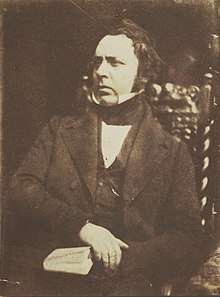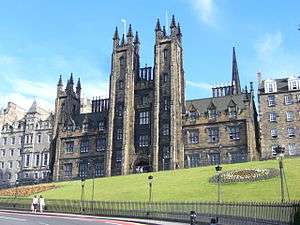James Bannerman (theologian)
| James Bannerman | |
|---|---|
 photograph of Bannerman by David Octavius Hill & Robert Adamson c. 1843-1847 | |
| Born |
9 April 1807 Cargill, Perthshire |
| Died |
27 March 1868 (aged 60) Grange Cemetery, Edinburgh |
| Nationality | Scottish |
| Education | University of Edinburgh, Princeton University |
| Occupation | Pastor, Theologian |
| Years active | mid 19th-century |
| Notable work | The Church of Christ, Inspiration |
| Spouse(s) | David Anne Douglas |
| Children | Rev Dr David Douglas Bannerman, James Patrick Bannerman |
| Theological work | |
| Tradition or movement | Free Church of Scotland (1843–1900) |
| Main interests | Ecclesiology, Biblical inspiration |
Rev Prof James Bannerman, D.D. (9 April 1807 – 27 March 1868), was a Scottish theologian.[1] He is best known for his classic work on Presbyterian ecclesiology, The Church of Christ, which continues to be widely read.
Life

Bannerman was the son of Reverend James Patrick Bannerman, minister of Cargill, Perthshire. He was born at the manse of Cargill on 9 April 1807, and after a distinguished career at the University of Edinburgh, especially in the classes of Sir John Leslie and Professor Wilson, became minister of Ormiston, in Midlothian, in 1833, left the Established Church for the Free Church in 1843, and in 1849 was appointed professor of apologetics and pastoral theology in the New College, Edinburgh, which office he held till his death, 27 March 1868.
In 1850 he received the degree of D.D. from Princeton College, New Jersey. He took a leading part in various public movements, especially in that which led in 1843 to the separation of the free church from the state, and subsequently in the negotiations for union between the nonconformist presbyterian churches of England and Scotland. His chief publications were:
- 1. Letter to the Marquis of Tweeddale on the Church Question, 1840
- 2. The Prevalent Forms of Unbelief, 1849
- 3. Apologetical Theology, 1851
- 4. Inspiration: the Infallible Truth and Divine Authority of the Holy Scriptures, 1865
- 5. The Church of Christ, also known as The Church: a Treatise on the Nature, Powers, Ordinances, Discipline, and Government of the Christian Church, 2 vols. 8vo; published after his death in 1868, and edited by his son[2]
- 6. A volume of sermons (also posthumous) published in 1869
Family
In 1839 he married David Anne Douglas (1821–1879), a daughter of the David Douglas, Lord Reston, one of the senators of the College of Justice. They had three sons and six daughters, including Rev Dr David Douglas Bannerman and James Patrick Bannerman.[3] A third son, Major General William Burney Bannerman FRSE (1858–1924), married Helen Brodie Cowan Watson, daughter of Robert Boog Watson,[4] and he and his wife are buried with the parents in the north-west section of the Grange Cemetery in Edinburgh.
References
- ↑ Wylie, James Aitken (1881). Disruption worthies : a memorial of 1843, with an historical sketch of the free church of Scotland from 1843 down to the present time. Edinburgh: T. C. Jack. pp. 15–22. Retrieved 18 August 2018.
- ↑ "James Bannerman". The Banner of Truth.
- ↑ http://www.mit.edu/~dfm/genealogy/bannerman.html
- ↑ http://www.royalsoced.org.uk/cms/files/fellows/biographical_index/fells_indexp1.pdf
![]()